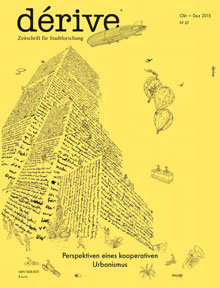pasture in Sekulic 2015
proprietary. Peter Linebaugh charted in his excellent book
_Magna Carta Manifesto_ , how the creation and development of the concept of
commons were closely connected to constantly changing relationships of people
and communities to the physical space. Here, I argue that the concept was
enriched when it was implemented in the digital field. Readdressing urban
space through the lens of digital commons can enable another imagination and
knowledge to appear around urban commons.
[](http://www.derive.at/)The
notion of commons in (urban) space is often complicated by archaic models of
organization and management - "the pasture we knew how to share". There is a
tendency to give the impression that the solution is in reverting to the past
models. In the realm of digital though, there is no "pasture" from the Middle
Ages to fall back on. Digital commons had to start from scratch and define its
own protocols of production and reproduction (caring and sharing). Therefore,
the digital commons and free software community can be the one to turn to, not
only for inspiration and advice, but also as a partner when addressing
questions of urban commons. Or, as Marcell Mars would put it "if we could
start again with (regulating and defining) land, knowing what we know now
about digital networks, we could come up with something
pasture in Stalder 2018
ifferent dimensions. The first of these
involves "common pool resources"; that is, *goods* that can be used
communally. The second dimension is that these goods are administered by
the "commoners"; that is, by members of *communities* who produce, use,
and cultivate the resources. Third, this activity gives rise to forms of
"commoning"; that is, to *practices*, *norms*, and *institutions* that
are developed by the communities
themselves.[^68^](#c3-note-0068){#c3-note-0068a}
In the commons, efforts are focused on the long-term utility of goods.
This does not mean that commons cannot also be used for the production
of commercial products -- cheese from the milk of cows that graze on a
common pasture, for instance, or books based on the content of Wikipedia
articles. The relationships between the people who use a certain
resource communally, however, are not structured through money but
rather through direct social cooperation. Commons are thus
fundamentally different from classical market-oriented institutions,
which orient their activity primarily in response to price signals.
Commons are also fundamentally distinct from bureaucracies -- whether in
the form of public administration or private industry -- which are
organized according to hierarchical chains of command. And they differ,
too, from public institutions. Whereas the latter are concerned with
society as a whole -- or at lea
te institutions.
Historically, many different commons-based institutions were developed,
and their number and variety have only increased under the digital
condition. Elinor Ostrom, who was awarded the 2009 Nobel Prize in
Economics for her work on the commons, has thus refrained from
formulating a general model for
them.[^69^](#c3-note-0069){#c3-note-0069a} Instead, she has identified a
series of fundamental challenges for which all commoners have to devise
their own solutions.[^70^](#c3-note-0070){#c3-note-0070a} For example,
the membership of a group that communally uses a particular resource
must be defined and, if necessary, limited. Especially in the case of
material resources, such as pastures on which several people keep their
animals, it is important to limit the number of members for the simple
reason that the resource in question might otherwise be over-utilized
(this is allegedly the "tragedy of the
commons").[^71^](#c3-note-0071){#c3-note-0071a} Things are different
with so-called non-rival goods, which can be consumed by one person
without excluding its use by another. When I download and use a freely
available word-processing program, for instance, I do not take away
another person\'s chance to do the same. But even in the case of digital
common goods, access is often tied to certain conditions. Whoever uses
free software has to accept its licensing agreement.
Internally
Display 200 300 400 500 600 700 800 900 1000 ALL characters around the word.